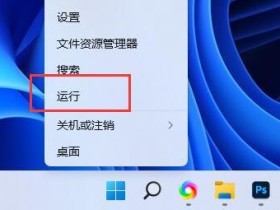文章目录
SpringBoot简介
SpringBoot其设计目的是用来简化Spring应用的初始搭建以及开发过程。该框架使用了特定的方式来进行配置,从而使开发人员不再需要定义样板化的配置,提供自动配置的“starter”项目对象模型以简化Maven配置,所谓约定大于配置。
本文重点分析springboot的starter机制,解析它如何把需要的类加载到spring容器中的过程,希望通过一步步分析使大家能够更好的理解其中的原理。
先找starter包中要加载的对象
从run方法开始
SpringBoot启动都是通过执行run方法,debug启动从run方法开始看




SpringApplication构造方法
跟了几个方法后,来到SpringApplication的一个构造方法
从方法名可以看出,这里要加载对象实例了
去哪找要加载的对象


对象在spring.factories文件里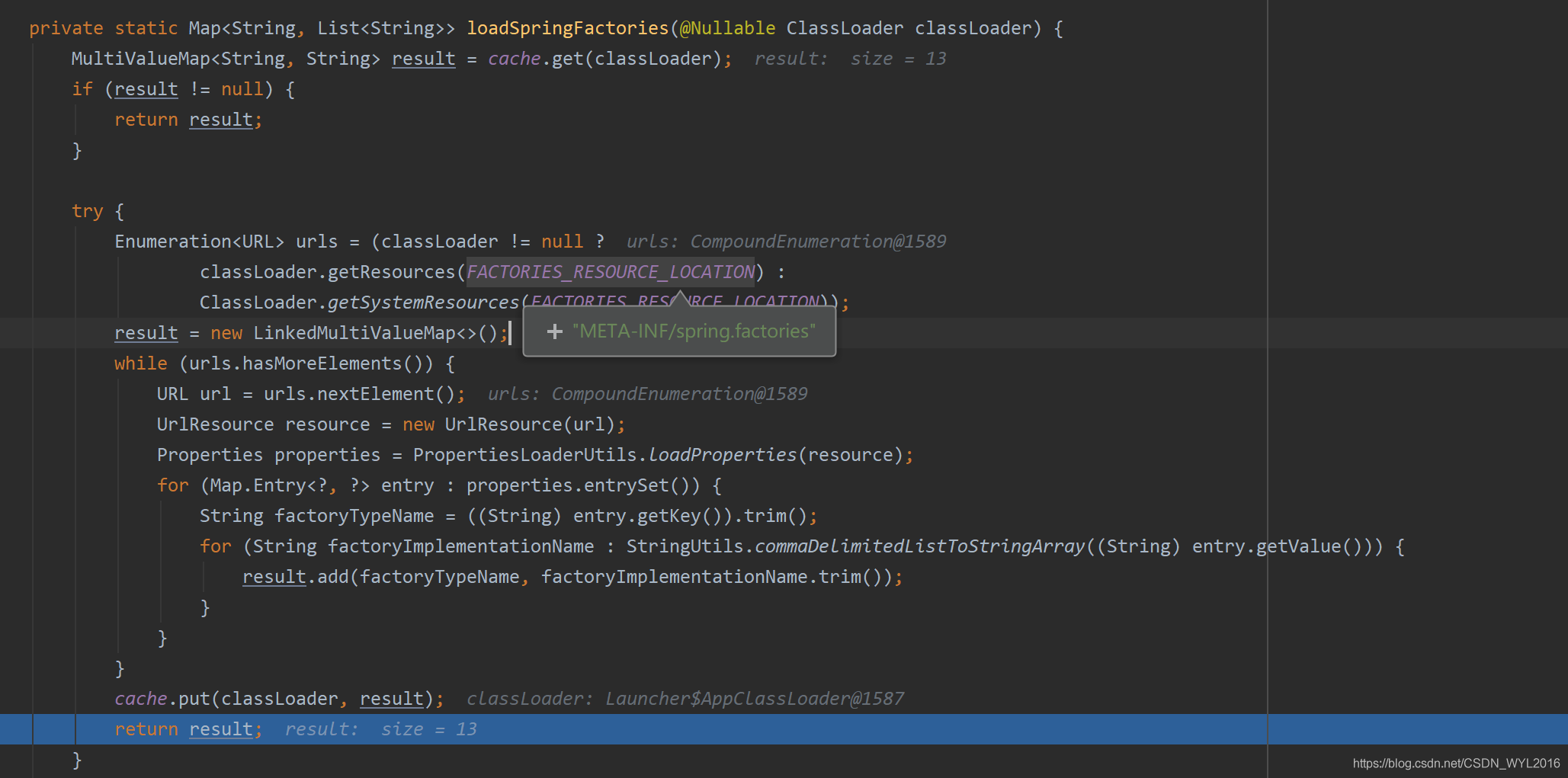
通过SPI机制扫描到META-INF/spring.factories文件中的内容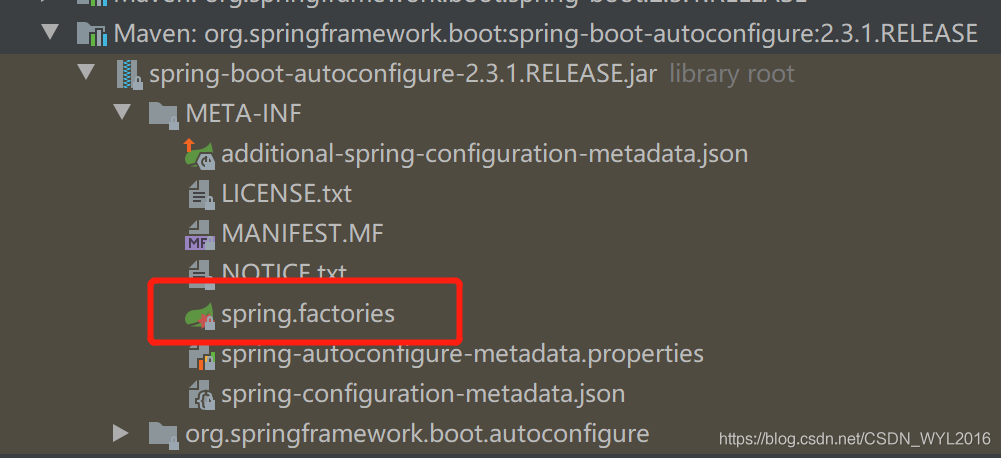
文件中的内容
把对象放入Map中
构造方法执行完,META-INF/spring.factories中的类就已经被加载到一个map容器中了。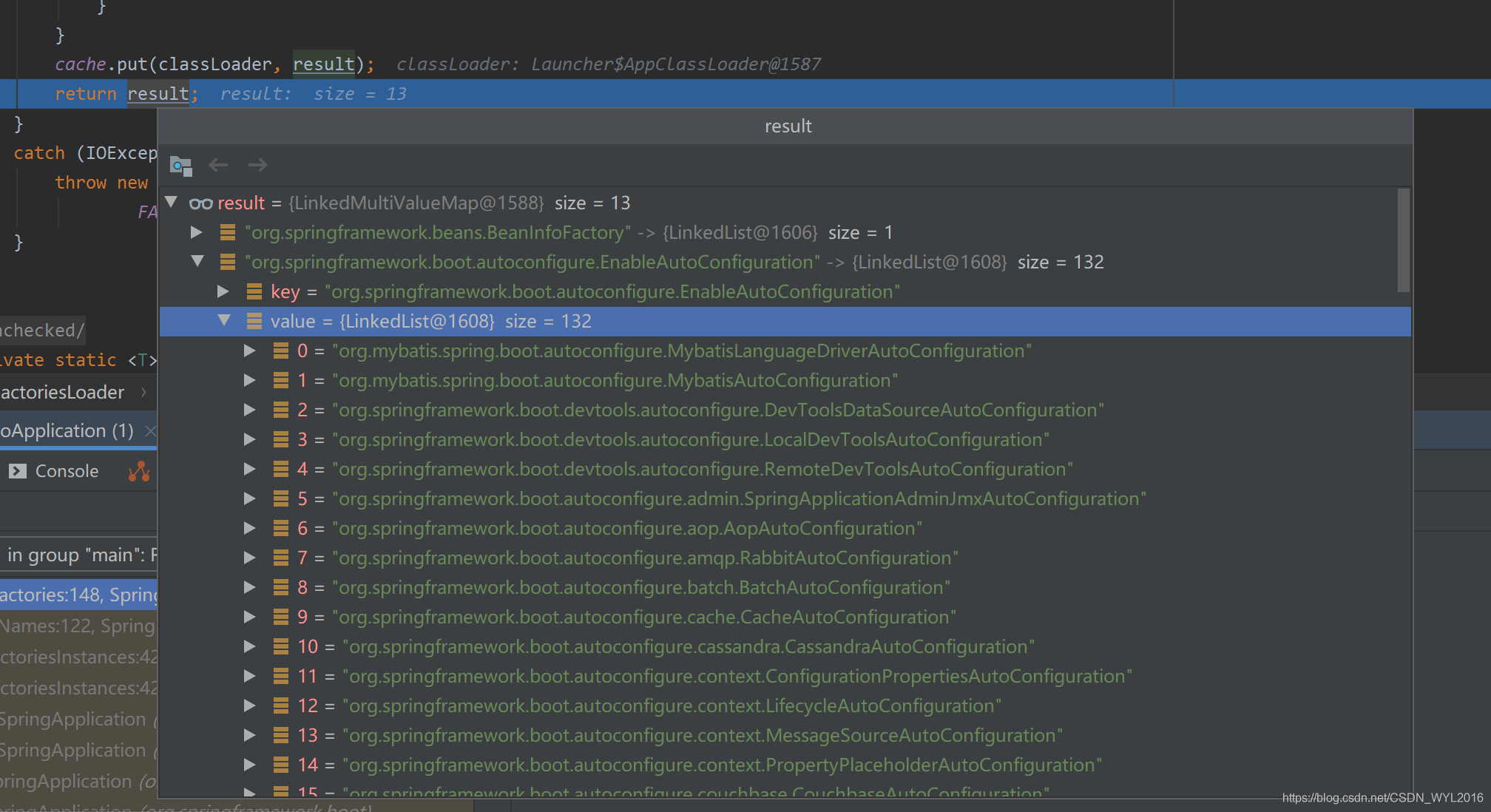
处理从spring.factories文件中找到对象
@SpringBootApplication注解的作用
接下来就是@SpringBootApplication注解发挥作用的时候了。
注解点进去
@Import注解
继续进入@EnableAutoConfiguration注解中,看到Import注解,了解spring的就知道spring会扫描到AutoConfigurationImportSelector这个类,这个类实现了DeferredImportSelector接口
public class AutoConfigurationImportSelector implements DeferredImportSelector, BeanClassLoaderAware,
ResourceLoaderAware, BeanFactoryAware, EnvironmentAware, Ordered
DeferredImportSelector是ImportSelector的子类,实现了这个接口的类,spring就会执行到process,selectImports这个两个方法。

process方法
public void process(AnnotationMetadata annotationMetadata, DeferredImportSelector deferredImportSelector) {
Assert.state(deferredImportSelector instanceof AutoConfigurationImportSelector,
() -> String.format("Only %s implementations are supported, got %s",
AutoConfigurationImportSelector.class.getSimpleName(),
deferredImportSelector.getClass().getName()));
AutoConfigurationEntry autoConfigurationEntry = ((AutoConfigurationImportSelector) deferredImportSelector)
//处理需要自动配置的
.getAutoConfigurationEntry(annotationMetadata);
this.autoConfigurationEntries.add(autoConfigurationEntry);
for (String importClassName : autoConfigurationEntry.getConfigurations()) {
this.entries.putIfAbsent(importClassName, annotationMetadata);
}
}
/**
* Return the {@link AutoConfigurationEntry} based on the {@link AnnotationMetadata}
* of the importing {@link Configuration @Configuration} class.
* @param annotationMetadata the annotation metadata of the configuration class
* @return the auto-configurations that should be imported
*/
protected AutoConfigurationEntry getAutoConfigurationEntry(AnnotationMetadata annotationMetadata) {
if (!isEnabled(annotationMetadata)) {
return EMPTY_ENTRY;
}
AnnotationAttributes attributes = getAttributes(annotationMetadata);
//返回候选的配置集合
List<String> configurations = getCandidateConfigurations(annotationMetadata, attributes);
configurations = removeDuplicates(configurations);
Set<String> exclusions = getExclusions(annotationMetadata, attributes);
checkExcludedClasses(configurations, exclusions);
configurations.removeAll(exclusions);
configurations = getConfigurationClassFilter().filter(configurations);
fireAutoConfigurationImportEvents(configurations, exclusions);
return new AutoConfigurationEntry(configurations, exclusions);
}
/**
* Return the auto-configuration class names that should be considered. By default
* this method will load candidates using {@link SpringFactoriesLoader} with
* {@link #getSpringFactoriesLoaderFactoryClass()}.
* @param metadata the source metadata
* @param attributes the {@link #getAttributes(AnnotationMetadata) annotation
* attributes}
* @return a list of candidate configurations
*/
protected List<String> getCandidateConfigurations(AnnotationMetadata metadata, AnnotationAttributes attributes) {
//通过SPI的方法,加载,启动时在run方法中已经加载过了
//getSpringFactoriesLoaderFactoryClass这个方法返回的就是EnableAutoConfiguration.class
List<String> configurations = SpringFactoriesLoader.loadFactoryNames(getSpringFactoriesLoaderFactoryClass(),
getBeanClassLoader());
Assert.notEmpty(configurations, "No auto configuration classes found in META-INF/spring.factories. If you "
+ "are using a custom packaging, make sure that file is correct.");
return configurations;
}
protected Class<?> getSpringFactoriesLoaderFactoryClass() {
return EnableAutoConfiguration.class;
}
public static List<String> loadFactoryNames(Class<?> factoryType, @Nullable ClassLoader classLoader) {
String factoryTypeName = factoryType.getName();
//之前在构造方法中加载时,EnableAutoConfiguration已经被加载过了,所以这边直接可以从map中获取
return loadSpringFactories(classLoader).getOrDefault(factoryTypeName, Collections.emptyList());
}

private static final Map<ClassLoader, MultiValueMap<String, String>> cache = new ConcurrentReferenceHashMap<>();
cache的key是classLoader,value又是一个map,其中key是EnableAutoConfiguration,value是spring.factories文件中对应的内容
private static Map<String, List<String>> loadSpringFactories(@Nullable ClassLoader classLoader) {
//直接从cache中获取
MultiValueMap<String, String> result = cache.get(classLoader);
if (result != null) {
return result;
}
try {
Enumeration<URL> urls = (classLoader != null ?
classLoader.getResources(FACTORIES_RESOURCE_LOCATION) :
ClassLoader.getSystemResources(FACTORIES_RESOURCE_LOCATION));
result = new LinkedMultiValueMap<>();
while (urls.hasMoreElements()) {
URL url = urls.nextElement();
UrlResource resource = new UrlResource(url);
Properties properties = PropertiesLoaderUtils.loadProperties(resource);
for (Map.Entry<?, ?> entry : properties.entrySet()) {
String factoryTypeName = ((String) entry.getKey()).trim();
for (String factoryImplementationName : StringUtils.commaDelimitedListToStringArray((String) entry.getValue())) {
result.add(factoryTypeName, factoryImplementationName.trim());
}
}
}
cache.put(classLoader, result);
return result;
}
catch (IOException ex) {
throw new IllegalArgumentException("Unable to load factories from location [" +
FACTORIES_RESOURCE_LOCATION + "]", ex);
}
}
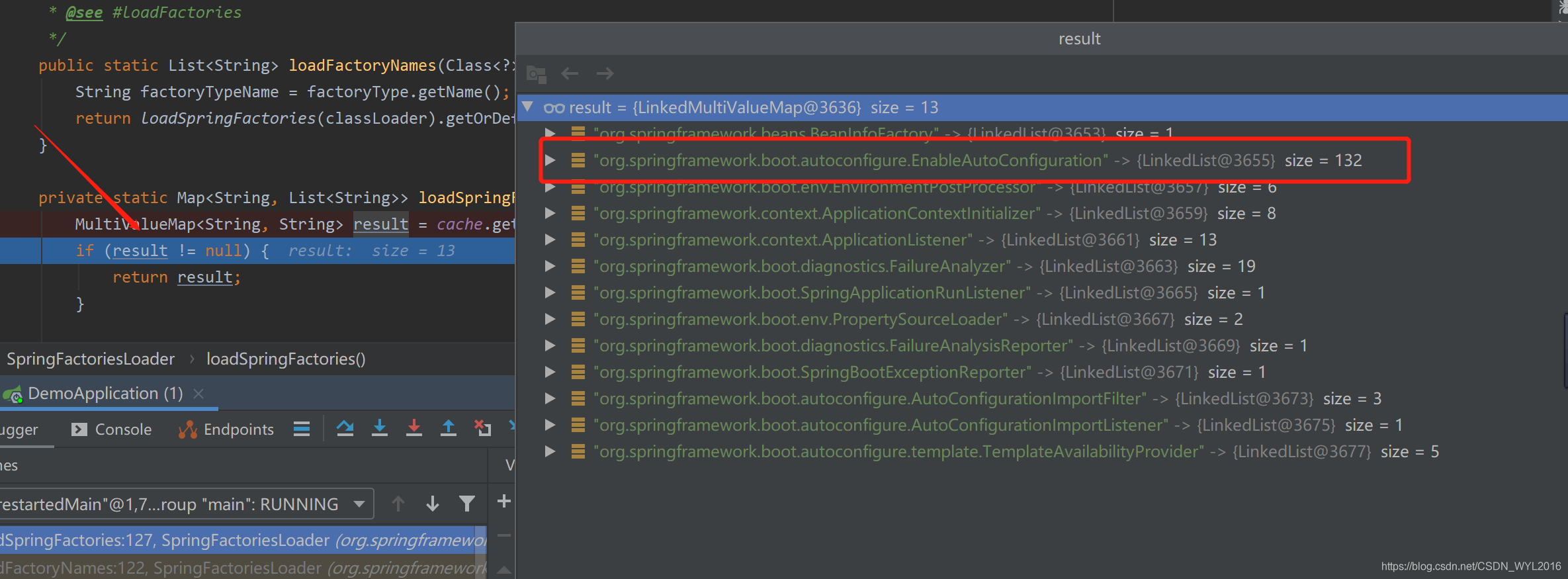
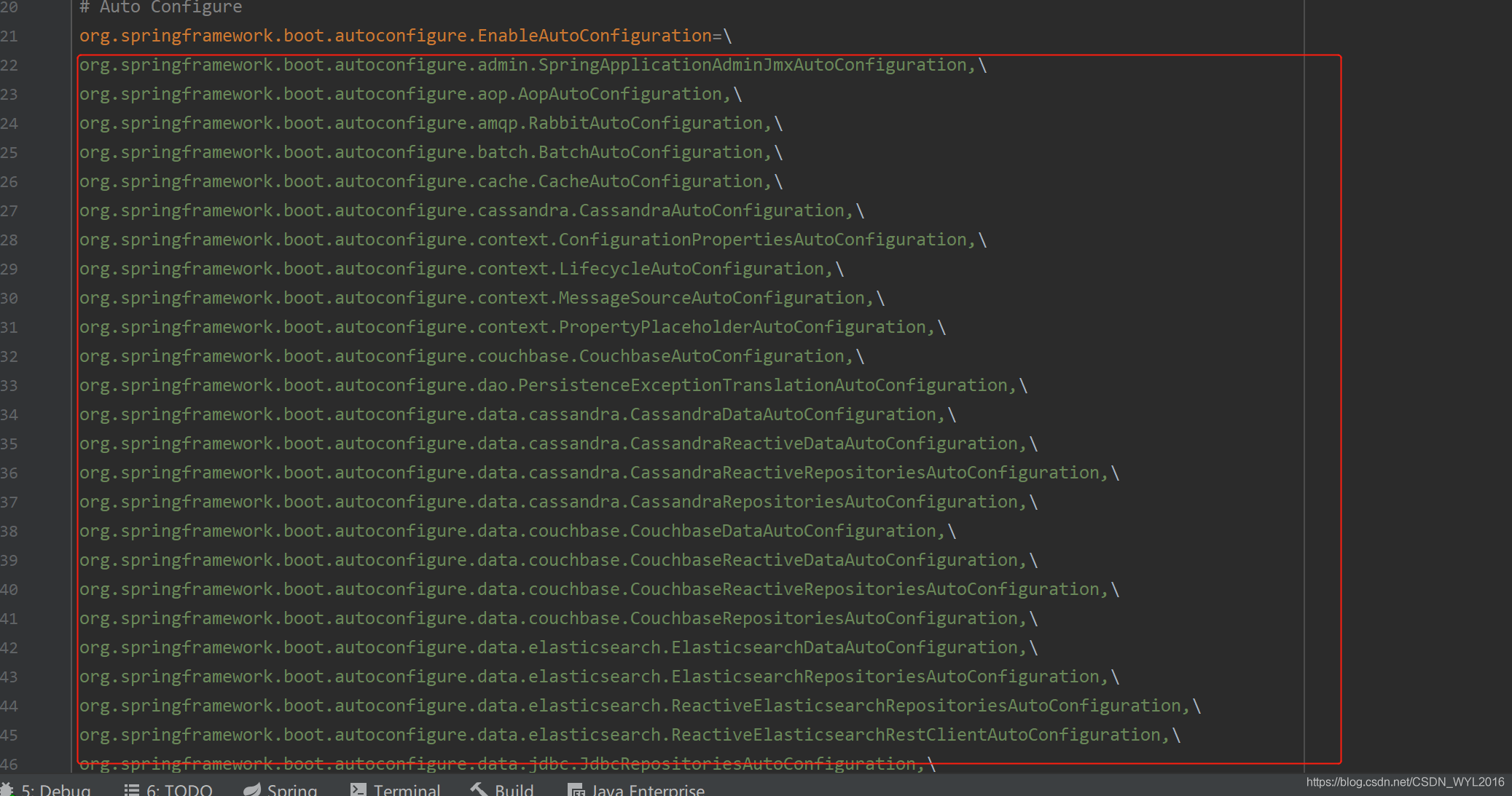
selectImports方法
这个方法主要就是封装了,把上面从factories文件中获取到的信息,封装成一个个Entry对象。
@Override
public Iterable<Entry> selectImports() {
if (this.autoConfigurationEntries.isEmpty()) {
return Collections.emptyList();
}
Set<String> allExclusions = this.autoConfigurationEntries.stream()
.map(AutoConfigurationEntry::getExclusions).flatMap(Collection::stream).collect(Collectors.toSet());
Set<String> processedConfigurations = this.autoConfigurationEntries.stream()
.map(AutoConfigurationEntry::getConfigurations).flatMap(Collection::stream)
.collect(Collectors.toCollection(LinkedHashSet::new));
processedConfigurations.removeAll(allExclusions);
return sortAutoConfigurations(processedConfigurations, getAutoConfigurationMetadata()).stream()
.map((importClassName) -> new Entry(this.entries.get(importClassName), importClassName))
.collect(Collectors.toList());
}
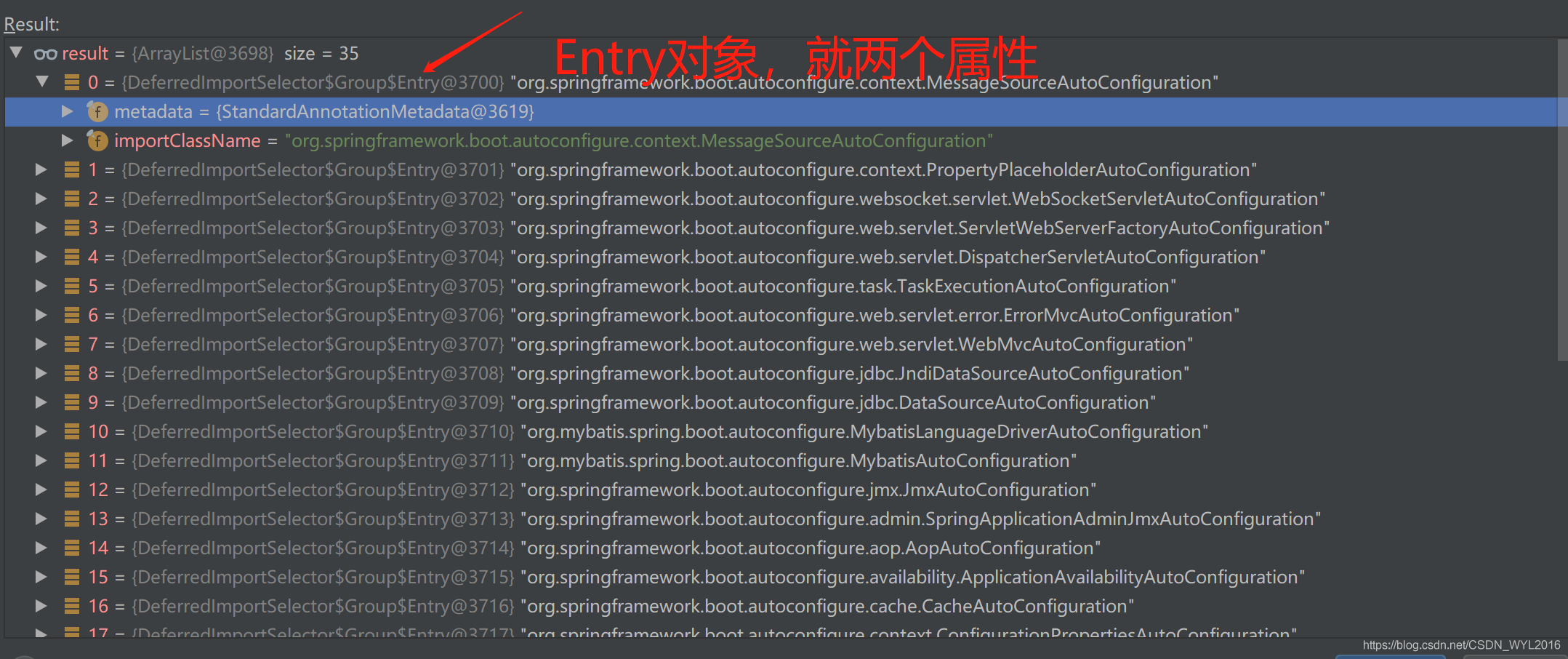
最后还是回到refresh方法
从刚刚的构造方法回来后,继续跟进run方法
public static ConfigurableApplicationContext run(Class<?>[] primarySources,
String[] args) {
return new SpringApplication(primarySources).run(args);
}
SpringBoot的主流程方法
public ConfigurableApplicationContext run(String... args) {
StopWatch stopWatch = new StopWatch();
stopWatch.start();
ConfigurableApplicationContext context = null;
Collection<SpringBootExceptionReporter> exceptionReporters = new ArrayList<>();
configureHeadlessProperty();
SpringApplicationRunListeners listeners = getRunListeners(args);
listeners.starting();
try {
ApplicationArguments applicationArguments = new DefaultApplicationArguments(
args);
ConfigurableEnvironment environment = prepareEnvironment(listeners,
applicationArguments);
configureIgnoreBeanInfo(environment);
Banner printedBanner = printBanner(environment);
context = createApplicationContext();
exceptionReporters = getSpringFactoriesInstances(
SpringBootExceptionReporter.class,
new Class[] { ConfigurableApplicationContext.class }, context);
prepareContext(context, environment, listeners, applicationArguments,
printedBanner);
// 其他方法就不看了,这个方法就会进入核心的refresh()方法中
refreshContext(context);
afterRefresh(context, applicationArguments);
stopWatch.stop();
if (this.logStartupInfo) {
new StartupInfoLogger(this.mainApplicationClass)
.logStarted(getApplicationLog(), stopWatch);
}
listeners.started(context);
callRunners(context, applicationArguments);
}
catch (Throwable ex) {
handleRunFailure(context, ex, exceptionReporters, listeners);
throw new IllegalStateException(ex);
}
try {
listeners.running(context);
}
catch (Throwable ex) {
handleRunFailure(context, ex, exceptionReporters, null);
throw new IllegalStateException(ex);
}
return context;
}
好了,到此后续的流程就是由ConfigurationClassPostProcessor把这些从factories文件中收集到的类,封装成BeanDefinition并加载到spring容器中了,这完全是Spring IOC部分的知识了,入口在refresh方法 —> invokeBeanFactoryPostProcessors的方法,
invokeBeanFactoryPostProcessors这个方法主要可以完成对有@Configuration 、@Component 、@Bean 、@ComponentScan 、@Import 、@ImportResource注解的收集,此处就不做深入解析了。





